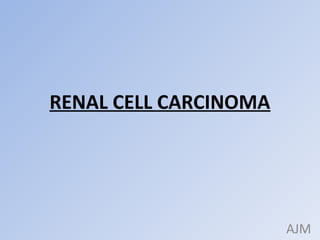
Renal cell carcinoma
- 1. RENAL CELL CARCINOMA AJM
- 2. A 60 yr old man presents with a feeling of fullness in his abdomen and 5kg weight loss over the past 6 months. Physical examination in entirely normal. Lab studies show Hb is 8.2g/dl, haematocrit is 24% and MCV is 70, Urine analysis shows haematuria(+++), but no protein, glucose or leucocytes. An abdominal CT scan shows a 11cm mass at the upper pole of the right Kidney. Right nephrectomy was performed and upon gross examination renal vein is seen distended by the tumor
- 4. 1. What is your diagnosis? 2. What are the Clinical manifestations of the disease?. 3. What are the gross and microscopic features?. 4. What is the prognosis .
- 5. WHAT IS THE DIAGNOSIS? Renal Cell Carcinoma(RCC). The diagnosis was based on the – Age of the patient – Chronic nature of his complaints – Massive haematuria – The detection of the mass on Abdominal CT examination – Invasion of the renal vein* – Significant weight loss*
- 6. • Classification of renal cell carcinoma is based on cytogenetic, genetic and histological features. • The major types of tumors are 1. CLEAR CELL CARCINOMA 2. PAPILLARY CARCINOMA 3. CHROMOPHOBE RENAL CARCINOMA 4. COLLECTING DUCT CARCINOMA
- 7. CLEAR CELL CARCINOMA • Most common • Loss of sequences on short arm of chromosome 3 (3p12 to 3p26). • This region harbors the VHL gene(3p25.3), which acts as a tumor suppressor gene in familial and sporadic forms. • It codes for pVHL which plays a role in ubiquination of proteins, and hence protein degradation.
- 8. • HIF-1 is an important target of pVHL, when it is mutated high levels of HIF-1 are maintained. • Insulin like growth factor another target of pVHL is also upregulated.
- 9. WHAT ARE THE GROSS AND MORPHOLOGICAL FEATURES?
- 10. MORPHOLOGY: 1. Arise from proximal tubular epithelium. 2. Solitary unilateral lesions. 3. Well defined margins and confined to the renal capsule 4. Spherical masses 5. Variegated areas that distorts the renal outline. 6. Large areas of *ischemic, *opaque, gray-white necrosis, *foci of haemorrhagic discolouration and *areas of softening.
- 11. MICROSCOPY: 1.Nests cells are seen. Nonpapillary pattern is seen 2.Cells are rounded or polygonal shape 3.Abundant clear or granular cytoplasm(vacuolated). 4.Tumors have delicate branching fibro vascular septae 5.Well differentiated ,but some show marked nuclear atypia.
- 13. PAPILLARY CARCINOMA • Papillary growth pattern • Occurs in both familial and sporadic forms. • Unlike clear cell carcinomas, papillary carcinomas are multifocal in origin.
- 14. MORPHOLOGY: 1. They are thought to arise from the DCT’s, 2. Multifocal and B/L. 3. They are typically haemorrhagic and cystic, especially when large. 4. Fungate through the walls of the collecting tubules to enter the ureter. 5. Invade the renal veins.
- 17. WHAT ARE THE CLINICAL FEATURES? * In 10% of cases a triad of 1. COSTOVERTEBRAL PAIN 2. A PALPABLE MASS 3. HAEMTURIA are seen. • The are generalised symptoms of fever malaise, weakness and weight loss.
- 18. • More than 10 cm in diameter when it is clinically detected. • RCC gives several false localising symptoms. • RCC can give rise to several paraneoplastic entities. • Metastasize widely before giving rise to any local symptoms or signs.
- 19. The common sites of metastasis are Lungs > Bones > LN’s > Liver > Adrenals > Brain
- 20. STAGING AND PROGNOSIS • Stage I: <7cms – Confined to the kidney. • Stage II: >=7cms – Conifined to the kidney. • Stage III: Tumors extend through the renal capsule but are confined to Gerotas fascia (IIIa). • Stage IV: Invaded adjacent organs(excluding kidney) or multile LN’s or distant metastasis
- 21. • The 5-year survival rate varies by stage: – >90%- Stage I – 85% - Stage II – 60% - Stage III – 10% - Stage IV
